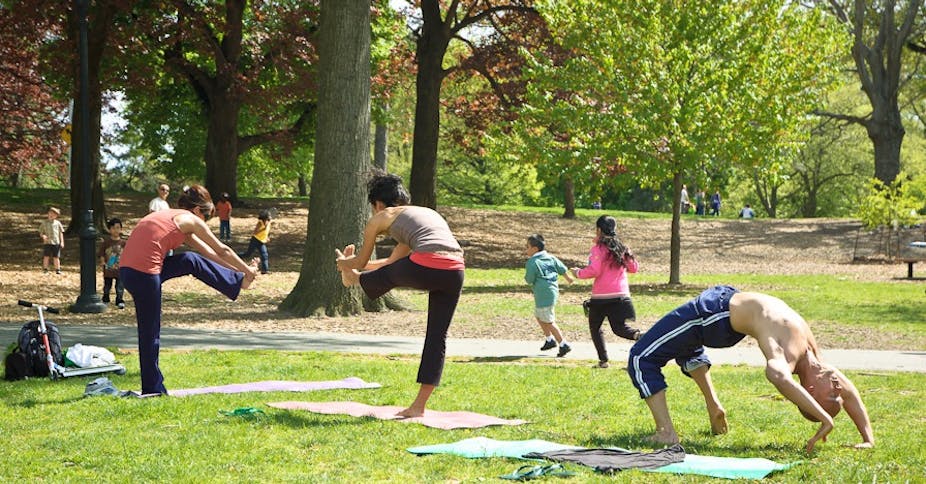Recent criticism of the use of public spaces for group-based exercise programs seems driven by opinion, not data. It also appears to be confounding the exercising with the management of public spaces.
This kind of criticism and its consequences can have far-reaching social impacts. After all, we are in the midst of an obesity epidemic that calls for an inclusive, whole-of-community approach to exercise. Communities are built “in public” and are, ideally, all inclusive; they are not built by staying indoors, or by withdrawing from public view.
A growing problem
Late last century, the federal government sought and was given advice about exercise and weight-control strategies for the general public. But things have not been going well.
According to data published last year, Australia was ranked sixth in terms of per capita BMI (body mass index) in 2006. The situation has worsened since then, and now there are more than 14 million Australians (around 56%) who are overweight or obese.
If current trends continue, that number will grow, by 2025, to include 80% of all Australian adults and 33% of all children. These data have prompted the federal government to spend serious money on “Healthy Communities” programs around the country over the last couple of years.
One such program being rolled out in an area of relative social and economic disadvantage is succeeding by using public space-based exercise. Rather than acting as a deterrent, group-based exercise programs have been attracting curious passers-by to join classes.
So successful have programs been that participants are demanding additional activities. And the only people complaining are the grounds-people with responsibility for keeping the grass alive under increasing wear and tear.
The program’s success has come from supporting the exercise novice into becoming an active participant. Traditional indoor exercise venues, including the gym, can intimidate the under-confident (through simple things such as too much lycra). Classes held in the local park, on the other hand, provide an easy entry point. Potential participants can see what’s going on and join in when they feel comfortable.
In other words, public displays of activity, even exercise, encourage people to participate. Most importantly, they do so across age and socioeconomic boundaries. That, in turn, has enabled participants to feel more connected to their community and to other people.
The right environment
Psychologists have known for some time that there are advantages to be gained from creating environments in which it’s safe for individuals to cooperate and to work together. Within a group, no one individual has to monitor everything all the time. And even group leaders can rely on the other members of the group to help and support each other.
That simple, but important, example of cooperation has influenced the evolution of human psychology. Groups of individuals working together are, on average, safer, stronger and more efficient than individuals working alone.
Indeed, working together is better for everyone because the group has more experience than any one individual and experience mediates risk. In addition, when we’re part of a group, we feel a responsibility to it. And we’re more likely to join in the group’s activity.
When it comes to exercising, for most of us, joining a group makes it more likely we will exercise. It also means the exercise is more likely to be effective.
But those very features of groups may also be at the heart of the tension arising from groups exercising in public spaces, or “commons”. When working together, the responsibilities felt by individual members of a group for their actions as part of the group are diminished. There is a diffusion of responsibility.
Two possible consequences of diffused responsibility are a reduction in awareness of both outsiders (those not in the group) and the impact on them of the group’s actions. Neither, however, is a consequence of exercising and neither is unmanageable.
Training for exercise groups leaders and personal trainers that makes clear their responsibilities for the actions of their groups can ameliorate this. Rather than banning groups from using public spaces for exercise, simple rules about where, how, and even when to expect groups (walkers, runners, boot campers, tai chi practitioners) removes ambiguity for everyone.
Guidelines for sharing spaces – for celebrating the activity of everyone from first-time joggers doing it tough up the hill in the local park to families walking together – can encourage the growth of exercising communities. It can inspire even the most exercise wary to join in.

